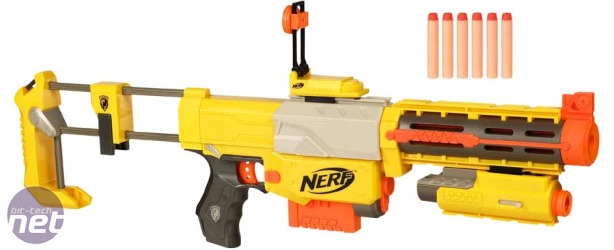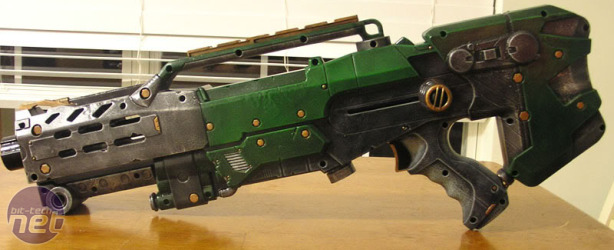
Nerf Gun Modding
Summer is here and for hardcore gamers like us that means two things – that there aren’t many good games coming out for the next few months and that we’ll be inevitably forced to go outside and enjoy some of that dastardly ‘sunshine’ that seems to be so popular these days.It can be an arduous time for those of us who’d rather be curled up at home with a copy of Dragon Age: Origins – and the only thing that can possibly make it all worthwhile is the chance to break out and dust off out some long-neglected, and perhaps slightly old fashioned entertainment. Over the next few weeks we’ll be looking at some of our favourite geeky toys, from Lego to remote control cars and helicopters, and reminding ourselves just how good they are – and, even better, in true bit-tech style, how they can be improved!
First on the list; Nerf guns. We’re willing to bet that nearly every bit-tech reader had a Nerf gun when they were growing up and, because jumping out of wardrobes and shooting your flatmates in the face with a foam dart never gets old, you may even still have them under your sofa or in the back of a cupboard. We know we still do!
Modding Nerf guns is nowhere near as complex as it can seem at first – part of what makes Nerf guns so great is how simple they are to operate. Nerf toys have, since their inception, always been designed for kids to use inside and so have been based around a robustness that means it’s actually hard to render one inoperable. Unlike air rifles or paintball guns, most Nerf guns don’t have any really complex mechanisms.
Before you go reaching for your crowbar and prying the side off your blessed blaster though, it’s worth bearing in mind that there are a few exceptions to this rule. Current Nerf blasters mainly use a hand-pumped mechanism which compresses air into a small chamber, where it is stored until someone pulls the trigger (or the air leaks away). When you pull the trigger then the air is expelled in one burst to the hollow Nerf dart, which catches the brunt of the force and flies through the air.
Older Nerf guns used different methods though – the blasters we had as kids, for example, didn’t have a trigger and were completely pump action. That means you’d pull a pump back and would then push it forwards (or just let go if it was spring-loaded) to fire. Models in this category, like the Nerf Bow ‘n’ Arrow or the Nerf Air Tech Ball Reactor Blaster (how do they come up with these names? – Ed) function on the same basic principle but are a bit more simple.
The main disadvantage of pump action Nerf blasters is that they can be a bit more exhausting to use, but on the plus side they can be a lot simpler to upgrade. All you really need to do to increase the firing force is improve the seals around the air chamber and pump harder, ensuring less air is lost and more pressure is generated.
At the other end of the spectrum there are even more advanced types of Nerf blaster like the Nerf Havok Fire which offer an entirely different level of entertainment. Battery powered and chain-fed, the Havok Fire is a vehicle of foamy destruction and carnage without even needing to be upgraded.
Not that that stops anyone though – there are still a plethora of mods out there for the Nerf Havok Fire, including ones which add LED ammo counters or that up-the firing speed to 500 rounds-per-minute! Mods like that are best left to the experts at NerfHaven to explain, but if you flip the page then we can guide you through one of the simplest ways to improve one of the most popular Nerf guns currently on sale – the Nerf Maverick pistol.

MSI MPG Velox 100R Chassis Review
October 14 2021 | 15:04










Want to comment? Please log in.